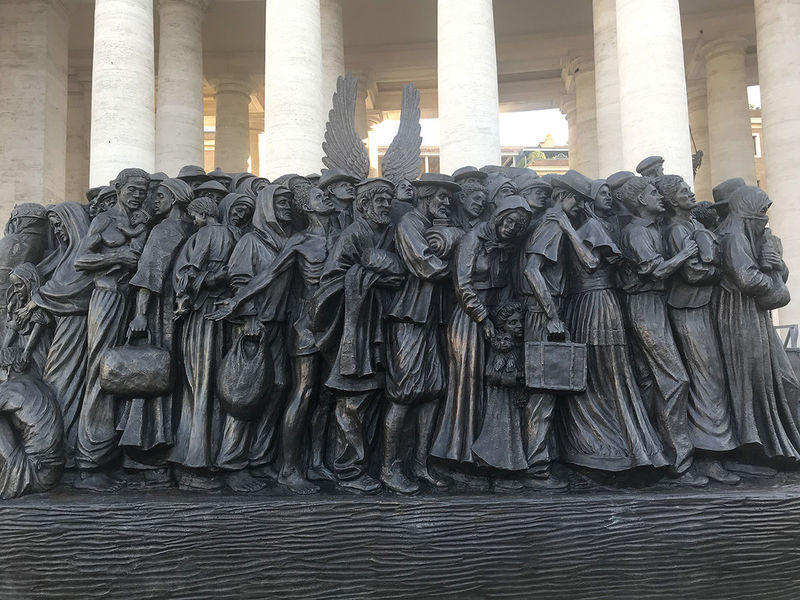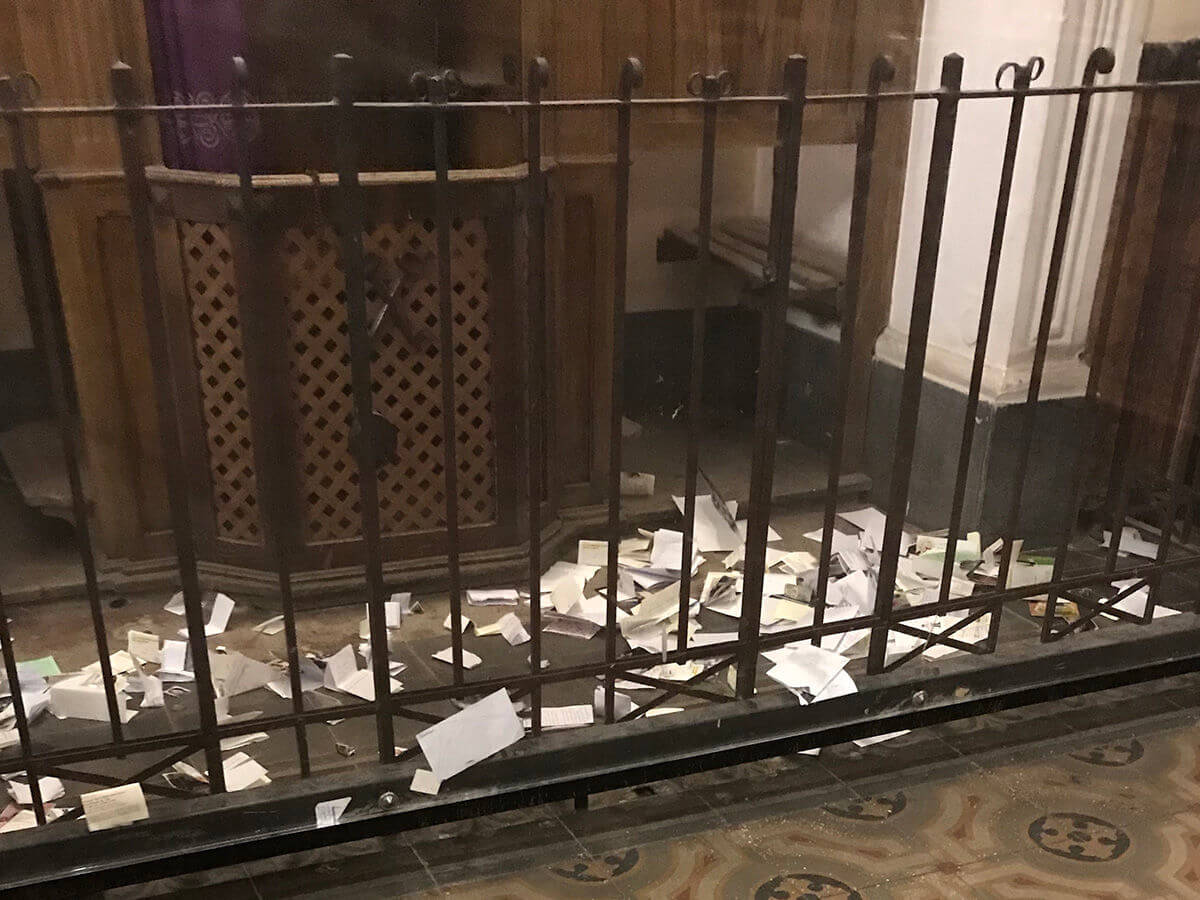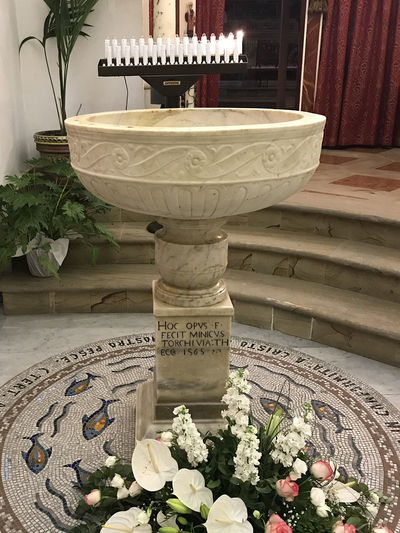 Angels Unawares. Photos by Father Joe Corpora
Angels Unawares. Photos by Father Joe Corpora
The fourth leg of my fall semester sabbatical took me to Italy for 11 days. Every time I go to Italy, within one hour at the most, I am convinced of two things: I will always be Catholic and I will always be fat.
I love the Church. I love the Church more and more every day. One trip to the Vatican renews my love for the Church. And mostly because its diversity and universality are on full display at the Vatican. I see devout pilgrims and inquisitive tourists. I see more priests in 10 minutes than I would see in the state of Montana in a month. I see nuns with the most interesting habits and colors and veils. I see people seeking God, wanting to be drawn closer to God. I can smell the goodness and love of Pope Francis.
I love the Church and, please God, I always will. The Church has revealed the merciful love of God to me. The Church, even with its blemishes and stains, is for me the way to God. I cannot imagine living for 10 seconds without the Eucharist and the sacraments. I love the Mass. I love the sacrament of confession, both as a sinner and as a confessor.
And then there’s the bread and the pasta and the cannolis. What else needs to be said? It’s practically impossible to be a Catholic if you don’t love bread. Every day I am in Italy I try to eat pasta twice a day, and on a good day three times! I love every kind of pasta, but especially gnocchi. I have never met a carbohydrate that I didn't like. And cannolis . . . with that ricotta cheese. To die for. If you have never had a good cannoli, stop reading this article and go get one. Today. Now.
I will always love the Church and I will always be fat. There are some things worth being forever.
I arrived on Saturday, September 21. On Sunday, I went to the Angelus. Every Sunday the Holy Father shows up in a window exactly at noon to pray the Angelus, to give a brief reflection on the Sunday Gospel and to greet those who have gathered. There were tens of thousands of people in St. Peter’s Square, which is always the case, rain or shine.
What is it about the Pope that will draw thousands of pilgrims every Sunday to travel from all around the world to see him and to listen to him for 10-12 minutes? Even in the rain? This Sunday was a very wet and rainy day. Nonetheless people showed up by the thousands to see Pope Francis. And I use the word “see” generously. He looks like a little white dot, even with my glasses. He is televised on big screens in four places in St. Peter’s Square so you can get a better look at him.
People come from all over to see him and to listen to him because he is the Holy Father and because he is real, authentic, kind, merciful and always smiling. People come because he is the Holy Father and because he is the person that He is. His message, as always, was great. He ends every Sunday Angelus by reminding us to pray for him and telling everyone to have a good lunch.
I love Pope Francis. It’s hard for me to understand why anyone would dislike him. I think about why people might dislike him and wish that he were not the Pope. I think it’s because he’s free. He is truly a free man. He has made the words of St. Paul his life. Christ died that we might be free. Jesus came to set us free. Pope Francis is free. He is not controlled by others. To the degree that a person is not free, to that degree, the ways and manners of Francis would drive him or her nuts.
So many of the Pope’s critics are people who are not free, who are bound to legalisms and rules in unhealthy ways. They are black and white people whereas the Pope has learned to live in gray, the real color of the world. Put another way, the Pope has a safety net that allows for error, for failure, for mistakes, even for sin — all of which are swallowed up and forgiven and forgotten in the relentless mercy of God. How difficult, even impossible, life would be if a person had to live in a black and white world with no safety net. It would be like living in a straightjacket. A safety net allows us to live in a gray world and allows for human beings to be human beings, allows for human beings to make mistakes, to fall, to sin and to know the Church’s longstanding teaching that the best success often grows from the soil of failure.
At the suggestion of my friend, Fr. John Herman, CSC, I made a pilgrimage to San Giovanni Rotondo to see the Church that Padre Pio, now St. Padre Pio, built and where he lived and served almost all his life as a Capuchin priest. It’s not easy to get to. You take the train from Rome to Foggia and then you take a bus from Foggia to San Giovanni Rotondo.
The first thing that I did was I went to look at the confessional where Padre Pio heard confessions every day for hours and hours. It’s a simple confessional now enclosed in glass. I prayed there several times during my two days in San Giovanni Rotondo. I prayed that I would listen well to people, that everyone who came to me for confession would leave more convinced of the merciful love of God, knowing more fully that God loves them and that nothing else really matters. I prayed to be a good confessor.

Inside the glass case enclosing the confessional of Padre Pio, there are hundreds of notes and scraps of paper that people have written to him. Of course Padre Pio is not going to read those notes. But we have to have a way of communicating with people we love. So people write him notes and tell him their cares and concerns and make requests of him as though he were sitting in the confessional. While looking at those notes and sitting there praying I had an insight into why the Church has saints. It is important that, in our search for God, we not be guided by concepts or ideas or notions. Rather by people. We really cannot be guided by love or kindness or compassion, as ideas. Rather we seek to follow people who are loving and kind and compassionate and merciful, like Padre Pio. We follow people, not ideas or concepts.
In one of the three churches on the property, Padre Pio’s body, completely incorrupt, is in a glass case. By the hundreds people file in front of his body to pray to him, to get a glimpse of him, to ask his intercession. There are lots of places to pray and to walk in San Giovanni Rotondo. After the evening Mass, which I concelebrated because you can get there at the last minute and still get a great seat, and some prayer time, I went to an ice cream place and had the best gelato ever. It’s called stracciatella, Italy’s version of chocolate chip, but so much better! Totally delicious and so sweet. As I ate my ice cream I thought about the sweetness of God. That ice cream was a great reminder of how sweet God is. As the psalmist says, “Taste and see the goodness of the Lord.” (Psalm 34)
I decided that I would travel to my grandparents’ village in Sicily. I flew from Rome to Palermo, took the bus to the train station, took the train to Santo Stefano Di Camastra and my second or third or fourth cousins (it never matters to Italians) picked me up and we drove to Castel Di Lucio. It’s about an hour drive from the train station way up in the mountains. The train ride from Palermo to Santo Stefano Di Camastra is beyond beautiful as the train travels all along the Mediterranean Sea. So beautiful even if it was a second-class train and I didn’t fit in the small seat and couldn’t find the bathroom!
A hundred years ago the population of Castel Di Lucio was almost 5,000 people. More than half the town emigrated from Castel because there was no work. And many of those people found their way to Easton, Pennsylvania, where I was born and grew up. Today there are 1,200 people in Castel Di Lucio. Sadly there is no future, because there is no work. One of my cousins leaves Castel Di Lucio every Monday morning with 40 other young men and they travel to work in Trapani or Palermo or Messina. They work there all week and return to Castel Di Lucio on Friday evening. Each week, the same routine.
If you ever get to Castel you’ll know why they don’t move to where there is work. This arrangement, as difficult as it is, allows them to live in this village with the cleanest air that has ever entered my lungs and the best food I have ever eaten. And did I say cannolis? They are a Sicilian invention and nowhere are they better than in Sicily. The people of Castel Di Lucio love their village and are so proud of it.
One hundred years ago there were nine parishes in Castel Di Lucio. Today there is one. One hundred years ago there were priests and nuns everywhere. Today there is one priest and zero nuns. I concelebrated at the Sunday Mass and the weekday Mass while I was there. I love the universality of the Church and, at the same time, the local flavor. I hear the local flavor in the music that the choir sings, in the gestures of the priest who preaches as much with his hands as with his words, in the way people greet each other before and after Mass.
The church looks remarkably like the one that I attended as a boy and in high school in Easton, Pennsylvania. The same statues and even in some instances in the same places! It’s so clear that when people move from one country to another country that they bring with them so much more than their clothes. They bring their language, their culture, their food, their customs, their way of loving God, their way of relating to one another, their devotions, their saints . . . in short, they bring their lives. When my grandparents came to Easton in 1918, along with hundreds of other families from Castel Di Lucio, they brought everyone and everything with them. I often think that when they woke up in the morning they wondered why the street signs were in English, because they lived and acted and prayed as though they were still in Castel Di Lucio. So interesting.

At the Sunday Mass there was a baptism, of Michele. I always love baptisms because babies and infants are so precious and strong signs of hope for the future of the Church and of the world. I loved listening to the priest ask the questions and the people respond all in Italian. I was especially moved because my grandfather was baptized in the same font that Michele was baptized in. My grandfather in 1901 and Michele in 2019. The same font, the same work and action of God the Father, God the Son, and God the Holy Spirit.
I also went to see the house that my grandmother grew up in. No one was home so I was not able to go inside. When no one was looking I took a stone from in front of the house. The Holy Father constantly reminds us that we should never lose touch with our culture, our ancestry, our beginnings. He often talks about the key role that his grandmother Rosa had and still has in his life.
In the airport in Palermo, I watched a father and son get into an argument. Had I not known where I was, I would have known just from watching and listening to the argument. I would have intuited that this is where I am from. It sounded and felt a lot like my home!
From Sicily I traveled back to Rome. I was able to go to St. Peter’s to see the sculpture of migrants and refugees that the Pope unveiled on September 29, the 105th World Day of Migrants. It’s called Angels Unawares and was done by the Canadian artist Timothy Schmalz.
It is breathtaking. The 104 figures stand together, shoulder to shoulder, huddled on a raft. Within this diverse crowd of people, angel wings emerge from the center, suggesting the presence of something sacred among them. The sculptural work suggests that the sacred is to be found in the stranger — in this case, among migrants and refugees. Since his first official trip outside Rome, to Lampedusa, the Holy Father has tirelessly directed our attention to the migrants and refugees, and has called us to open our hearts, our homes, our countries to them.
Not only was I able to see this great sculpture, I met the artist. Tim Schmalz and I had a wonderful 20-minute conversation about his work, how he did it, how he has been inspired by Pope Francis, and the Holy Father’s vision for the sculpture. It is the first piece of sculpture installed in the piazza in over 400 years.
Pope Francis has said often, “Let the Church always be a place of mercy and hope, where everyone is welcomed, loved, and forgiven.” Amen.
One last thing: Unlike Americans who shout when the person to whom they are speaking does not understand English, and unlike the French who do the same thing, Italians just shout all the time. It’s hilarious. I didn’t have to put my hearing aids one time while being in Italy! So many reasons to love Italy.
Lord, Jesus Christ, Son of the Living God, have mercy on me, a sinner.
Fr. Joe Corpora, C.S.C., on sabbatical for the Fall 2019 semester, has renamed his regular “Being Mercy” column “Doing Mercy” as he chronicles his experiences around the world during his active leave from campus.